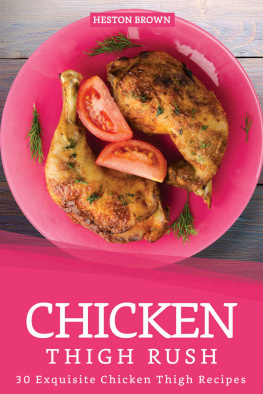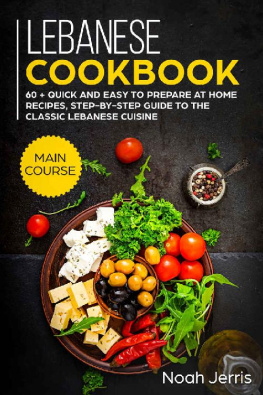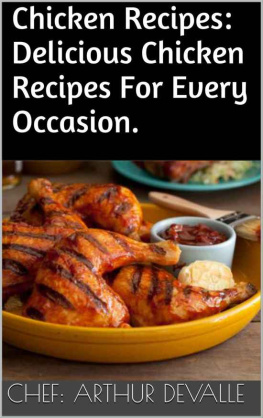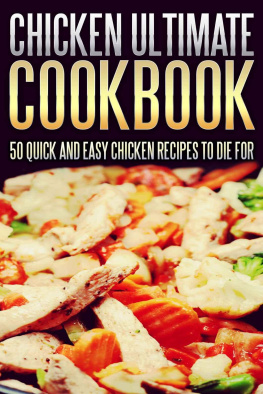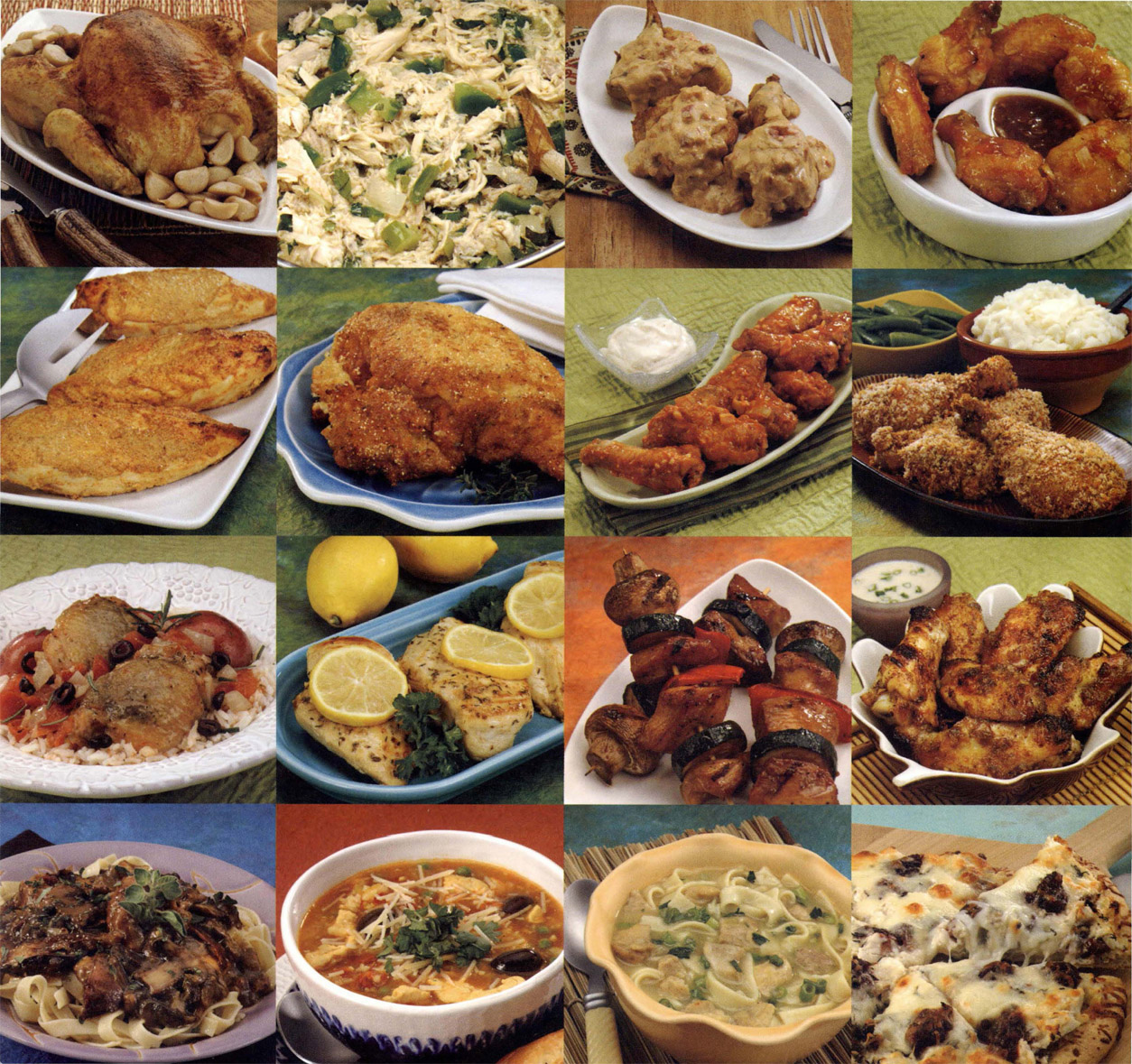GLOSSARY
Learn the language first
Adobo: A sauce made of garlic, vinegar, spices, and soy sauce used to season dishes.
Al dente: Italian phrase meaning to the tooth describes doneness of pasta.
Beat: To manipulate food with a spoon, mixer, or whisk to combine.
Bread: To coat chicken with crumbs or crushed crackers before baking or frying
Brine: A mixture of salt, sugar, and water used to season chicken and turkey before cooking.
Broth: Liquid extracted from meats and vegetables, used as the basis for most soups.
Browning: Cooking step that caramelizes food and adds color and flavor before cooking.
Coat: To cover food in another ingredient, as to coat chicken breasts with breadcrumbs.
Chill: To refrigerate a food or place it in an ice-water bath to rapidly cool it.
Chop: To cut food into small pieces, using a chefs knife or a food processor.
Chowder: A soup thick with vegetables and meats, usually seafood, thickened with cream and cheese.
Cornish Hen: A very young chicken, sold whole. Usually stuffed and roasted.
Cutlet: A thin cut of chicken or turkey, either pounded thin or cut very thin to cook quickly.
Deglaze: To add a liquid to a pan used to saut meats; this removes drippings and brown bits to create a sauce.
Dice: To cut food into small, even portions, usually about inch square.
Drippings: Brown bits made of meat, skin, and fat left in the pan after chicken is browned.
Flake: To break into small pieces; canned meats are usually flaked.
Fricassee: A dish made by stewing meats, especially chicken or turkey, with vegetables.
Gazpacho: A cold soup, usually made of tomatoes, that is pureed without cooking.
Grate: To use a grater or microplane to remove small pieces or shreds of skin or food.
Grill: To cook over coals or charcoal, or over high heat.
Marinate: To allow meats or vegetables to stand in a mixture of an acid and oil, to add flavor and tenderize.
Melt: To turn a solid into a liquid by the addition of heat.
Nioise: Word means as prepared in Nice, a town in France. Usually made with olives, tomatoes, and bell peppers.
Panfry: To cook quickly in a shallow pan, in a small amount of fat over relatively high heat.
Poultry: A broad category of birds kept for their eggs and meat, including chicken, turkey, Cornish hens, geese, and ducks.
Shred: To use a grater, mandoline, or food processor to create small strips of food.
Simmer: A state of liquid cooking, in which the liquid is just below a boil.
Slow cooker: An appliance that cooks food by surrounding it with low, steady heat.
Soup: A mixture of solids and liquids, served hot or cold, as a main dish or part of a multi-course meal.
Spatchcocked: A technique that removes the backbone and flattens chicken so it is easily grilled.
Toss: To combine food using two spoons or a spoon and a fork until mixed.
Whisk: Both a tool, which is made of loops of steel, and a method, which combines food until smooth.
CHICKEN CLASSICS
Copyright 2010 by Morris Book Publishing, LLC
ALL RIGHTS RESERVED. No part of this book may be reproduced or transmitted in any form by any means, electronic or mechanical, including photocopying and recording, or by any information storage and retrieval system, except as may be expressly permitted in writing from the publisher. Requests for permission should be addressed to Globe Pequot Press, Attn: Rights and Permissions Department, P.O. Box 480, Guilford, CT 06437.
Knack is a registered trademark of Morris Publishing Group, LLC, and is used with express permission.
Editor-in-Chief: Maureen Graney
Editor: Katie Benoit
Cover Design: Paul Beatrice, Bret Kerr
Text Design: Paul Beatrice
Layout: Casey Shain
Cover photos by Debi Harbin
Interior photos by Debi Harbin
Library of Congress Cataloging-in-Publication Data
Larsen, Linda Johnson.
Knack chicken classics : a step-by-step guide to favorites for every season / Linda Johnson Larsen ; photographs by Debi Harbin.
p. cm.
Includes index.
ISBN 978-1-59921-617-1
1. Cookery (Chicken) I. Title. II. Title: Chicken classics.
TX750.5.C45L37 2010
641.6'65dc22
2009032195
The following manufacturers/names appearing in Knack Chicken Classics are trademarks:
Amazon.com
Boboli
Crock-pot
Epinions.com
Ibarra
Taza
The information in this book is true and complete to the best of our knowledge. All recommendations are made without guarantee on the part of the author or Globe Pequot Press. The author and Globe Pequot Press disclaim any liability in connection with the use of this information.
Printed in China
10 9 8 7 6 5 4 3 2 1
Acknowledgments
Thanks to my dear husband, Doug, for always being there for me, and to my agent, Barb Doyen, for all her help and support. And to my family and friends who love to eat what I make! And thanks to photographer Debi Harbin, for her wonderful work bringing the recipes to life.
Photographer Acknowledgments
Thank you to my three assistants for their help on this book: Michelle Feeser, Cliff Harbin, and Tina Jones.
Debi Harbin
INTRODUCTION
If chicken is on the table for dinner, everyone will be happy. This bird and its relatives, like the turkey and Cornish game hen, are easy to prepare and adapt to the foods and flavors of any cuisine. Children love chicken, and it is a nutritious addition to any familys diet.
Chickens are available in a dizzying array of cuts and types, ranging from boneless, skinless breasts and thighs to thin cutlets, whole chickens, wings, and giblets. The cook should prepare each cut a little bit differently for the most tender and juicy results. Whether you grill chicken, cook it in a slow cooker, stir-fry it in a wok, or cook it in a microwave, these tips and tricks will ensure the best results no matter what.
Every cuisine in the world has some recipes for chicken. Some are classic, like Chicken Paprikash or Lemon Chicken, and some are more adventurous, like Tandoori Chicken and Portuguese Chicken Stew. Simple roasted chicken can be flavored with curry powder or olives, and stir-fried chicken is delicious with anything from baby corn and water chestnuts to bell peppers and onions.
This tender and mild meat pairs perfectly with many flavors, including onions and garlic or peaches and thyme. You can make a mild chicken in a creamy sauce, a crisp chicken prepared with hot chile peppers, or a simple roast chicken with lots of herbs.
There are two types of heat used to cook chicken: wet and dry. Wet heat includes steaming, boiling, poaching, slow cooking, and braising. Dry heat includes baking, roasting, broiling, grilling, panfrying, and deep-frying.


